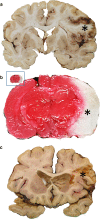Ischemic stroke: experimental models and reality
- PMID: 28064357
- PMCID: PMC5250659
- DOI: 10.1007/s00401-017-1667-0
Ischemic stroke: experimental models and reality
Abstract
The vast majority of cerebral stroke cases are caused by transient or permanent occlusion of a cerebral blood vessel ("ischemic stroke") eventually leading to brain infarction. The final infarct size and the neurological outcome depend on a multitude of factors such as the duration and severity of ischemia, the existence of collateral systems and an adequate systemic blood pressure, etiology and localization of the infarct, but also on age, sex, comorbidities with the respective multimedication and genetic background. Thus, ischemic stroke is a highly complex and heterogeneous disorder. It is immediately obvious that experimental models of stroke can cover only individual specific aspects of this multifaceted disease. A basic understanding of the principal molecular pathways induced by ischemia-like conditions comes already from in vitro studies. One of the most frequently used in vivo models in stroke research is the endovascular suture or filament model in rodents with occlusion of the middle cerebral artery (MCA), which causes reproducible infarcts in the MCA territory. It does not require craniectomy and allows reperfusion by withdrawal of the occluding filament. Although promptly restored blood flow is far from the pathophysiology of spontaneous human stroke, it more closely mimics the therapeutic situation of mechanical thrombectomy which is expected to be increasingly applied to stroke patients. Direct transient or permanent occlusion of cerebral arteries represents an alternative approach but requires craniectomy. Application of endothelin-1, a potent vasoconstrictor, allows induction of transient focal ischemia in nearly any brain region and is frequently used to model lacunar stroke. Circumscribed and highly reproducible cortical lesions are characteristic of photothrombotic stroke where infarcts are induced by photoactivation of a systemically given dye through the intact skull. The major shortcoming of this model is near complete lack of a penumbra. The two models mimicking human stroke most closely are various embolic stroke models and spontaneous stroke models. Closeness to reality has its price and goes along with higher variability of infarct size and location as well as unpredictable stroke onset in spontaneous models versus unpredictable reperfusion in embolic clot models.
Keywords: Animal model; Cerebral ischemia; Focal ischemia; In vitro model; Non-human primate; Stroke.
Conflict of interest statement
CJS is supported by a grant from the German Research Foundation (Deutsche Forschungsgemeinschaft, DFG; SO 908/3-1). CJS is the inventor of the patent application “Hematopoietic factors for treatment of neurological condition” including stroke and other diseases. Recently, a part of the application (ALS) was granted. CJS transferred his rights to Sygnis and received a minor financial compensation upfront. In case of efficacy, he participates in the form of royalties.
Figures



References
Publication types
MeSH terms
LinkOut - more resources
Full Text Sources
Other Literature Sources
Medical

